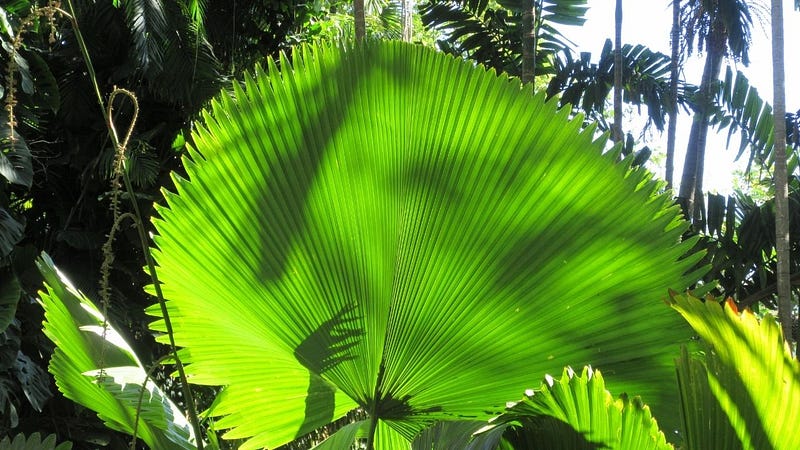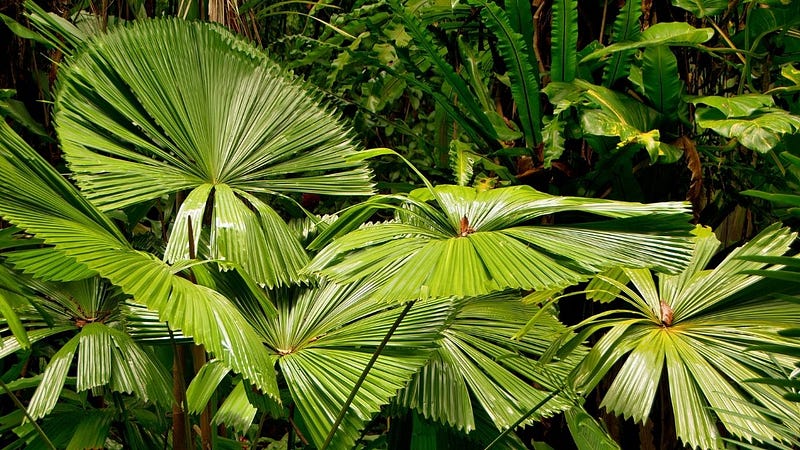
Not everybody has the appropriate fan palm tree care (Livistona Chinensis) conditions in their yard to get a taste of the tropical plant.
This does not, however, prevent gardeners from appreciating the casual, but beautiful sense of tropical plants. Fan palm trees are one of the most popular Indoor tropical plants, and they flourish in strong light and plenty of room. Proper planting ensures that your palm tree gets off to the best possible start, resulting in robust, trouble-free development for years to come.
We’ve covered all of the planting guidelines and cleared up any ambiguity surrounding the correct selection and planting o f fan palm in this article.
Is A Palm Tree Easy To Grow?
The Fan Palm is a large palm with fan like fronds that can reach a width of 2 feet (60 cm). When fully developed, this palm frond fan is a thing of beauty. It is a charming decorative for the house because of its broad, fan-shaped leaves held on long branches.
This palm is easy to grow and adapts to ordinary house temperatures. If you take proper care of your indoor palm, you’ll be able to enjoy it for many years.
Fan Palm Plant Profile
A palm tree is the quintessential icon of a tropical and beachy paradise. Proper planting is the first stage of correctly growing palm fan trees, and the processes for planting a new palm aren’t difficult. Let us now understand what is fan palm tree?
Fan Palm Tree Care And Grow Tips Indoors?
When growing your palm trees indoors, here below are some of the factors to consider for a proper indoor palm care.
1. Temperature
The plant requires 70–80°F/21–27°C during the day and 55–60°F/13–16°C in the night. In the winter, move your palm away from heat or AC vents and chilly gusts from entrances and windows. Dry air and chilly drafts are not good for the Chinese palm.
Add 1 part fine sand to 2 parts marsh moss-based potting mix. Porous soil mixture, such as a mix of peat moss, leaf mold, and crushed bark, is ideal for palm trees.
You can buy a palm fan soil combination developed especially for growing palm plants, but they’ll do just well in regular commercial potting soil. If you have a habit of forgetting to water your plants, peat moss or vermiculite can be added to the multi-purpose potting soil mix to assist in retaining moisture.
Good care of indoor plam tree is to leave the soil to dry somewhat between waterings after fully watering. In the winter, when growth has stalled, reduce the watering rate. As tap water could contain fluoride, chlorine, and other chemicals that might harm the palms, use distilled water when watering.
To avoid rot, prevent getting the base of the palm wet when watering. To avoid damp soil, choose a container with good drainage holes and a rapidly draining potting mix.
4. Space Between Plants
Before they mature, fan palm leaf expands their wings. They should be spaced at least 5 feet away from the house to allow them to spread out while they’re young and allow them to have ample frond room as they age.
When considering plantingpalm trees in a pot indoors be weary of the palm tree container size and spacing. When you are planting a 7-gallon pot size, position them about 4 feet apart for a group planting for seclusion or depth.
Palms should be planted 3 feet apart in a 3-gallon pot.
5. Companions
Try planting companion trees like fake aralia, white fountain grass, agapanthus, and dracaena, based on the lighting condition.
Ways Taking Care Of A Fan Palm Tree Outdoors
Palm plants, like all other plants, need specific attention yet they are low-maintenance plants. They usually don’t have huge issues with pest and disease, but some time bugs like mealybug, and powdery mildew can damage plant and lead to kill.
The and the top of the neighboring ground provide the majority of the nutrients for palm plants. This implies you’ll need to provide sufficient fertilizers to the soil. Adding natural calcium and nitrogen can also help plants growth.
During the first six months, the growing fan palm trees should be watered at least twice a week. Provide it enough water to ensure that moisture reaches 12 feet below the soil. If you’re growing a palm tree on sandy soil, you’ll need to supply more water since sandy soil doesn’t hold moisture.
The watering technique will be determined by the season, climate, and frequency of rainfall once the plant has established itself. In most situations, farmers water their plants twice a month throughout the summer, and once every six weeks during wintertime.
3. Fertilization
Manganese, iron, and zinc deficiencies are all present in palms. Lower the soils ph with the aid of moss peat or liquid sulfur. Palm trees require a different fertilizer than other plants, which is 8–2–12. Keep in mind that the top soil layer provides nutrient for the palms.
How to care for a palm tree houseplant. Care for the plant by pruning it, the majority of palm fan plants naturally shed their fronds. Clip off the yellow or brown old fronds while trimming since they deplete the tree’s nutrition.
Trim the branches away from the trunk as much as possible to avoid damaging the tree. Pruning off more leaves than the tree produces in a year is not a good idea because the Chinese fan plant growth rate will be hindered as a result of this.
What Are The Types Of Fan Palms?
Below are some of the different types of palm houseplants that you can beautify your house with.

1. Chinese Fan Palm (Livistona chinensis)
The Chinese palm fan, sometimes known as the fountain palm, is a tropical palm tree native to East Asia. Southern Japan, Taiwan, the Ryukyu Islands are also places where we can find this fan specie.
2. Areca Palm (Dypsis lutescens)
Dypsis lutescens, commonly called butterfly palm, is a flowering plant native to Madagascar, it belongs to the Arecaceae family.
3. Majestic Palm (Ravenea rivularis)
Ravenea rivularis, often known as the magestic palm or majesty palm, is a tree of the Arecaceae family. The grandeur palm grows to a height of 98 feet in its natural condition, despite being sold as a palm tree in a planter in shops. It’s a Madagascar native.
4. Cascade Palm (Chamaedorea cataractarum)
The cat palm, also known as the cascade palm or cataract palm, is a tiny palm tree. Southern Mexico and Central America are its natural habitats.
5. Parlor Palm (Chamaedorea elegans)
The ponytail palm, scientifically known asBeaucarnea recurvata, is a plant belonging to the Asparagaceae family. The species was once found in a number of states throughout eastern Mexico, but it is currently only found in the state of Veracruz.
6. Ponytail Palm (Beaucarnea recurvata)
This specie of fan palm from the plant family Asparagaceae is popularly called the elephant’s foot palm. The species was once found in a number of states throughout eastern Mexico, but it is currently only found in the state of Veracruz.
7. Sago Palm (Cycas revoluta)
Cycas revoluta is a gymnosperm indigenous to south Japan and the Ryukyu Islands, belonging to the Cycadaceae family. It’s one of several different species used to manufacture sago.
8. Yucca Palm (Yucca elephantipes)
Yucca gigantea is a flowering plant indigenous to Mexico and Central America and belongs to the asparagus family. It g rows up to a height of 8–12 meters.
9. Mexican fan palm
The Mexican fan palm, with scientific name Mexican washingtonia, is a tree species in the Arecaceae family. The palm tree is indigenous to western Sonora in northern Mexico.
10. European fan palm
Chamaerops is a flowering plant species of the Arecaceae family. Chamaerops humilis, often known as the European fan palm or the Mediterranean dwarf palm.
11. Ruffled fan palm
Licuala Grandis, also known as the Pala’s palm, is a fan palm tree species that is unique to Vanuatu, a Pacific island nation.
12. Mediterrrian fan palm
Chamaerops is a flowering plant species of the Arecaceae family. Chamaerops humilis, can alos be called the Mediterranean dwarf palm.
13. Fiji fan palm
The Fiji fan palm, Pritchardia Pacifica, is a palm tree genus indigenous to Tonga of the genus Pritchardia. It’s also found in Fiji, Samoa, and the Marquesas.
14. California fan palm
The palm tree is scientifically known as Washingtonia filifera, and popularly called the California palm. The fan palm tree is a blooming palm common to the extreme southwest of the United States and Baja California.
Read complete guide here.




























